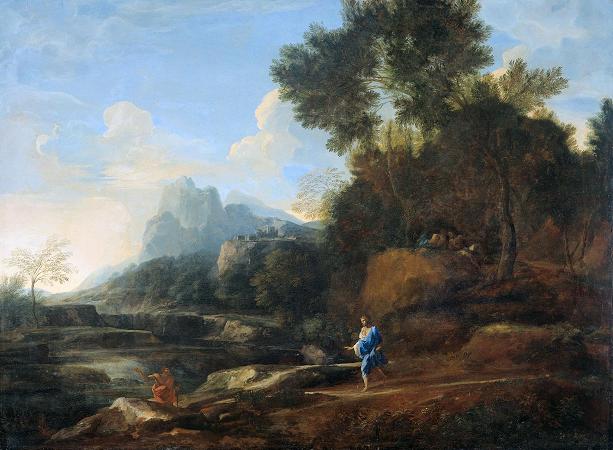Nicolas Poussin (1594 - 1665). Nicolas Poussin was the leading painter of the classical French Baroque style, although he spent most of his working life in Rome. Most of his works were on religious and mythological subjects painted for a small group of Italian and French collectors. He returned to Paris for a brief period to serve as First Painter to the King under Louis XIII and Cardinal Richelieu, but soon returned to Rome and resumed his more traditional themes. In his later years he gave growing prominence to the landscapes in his pictures. His work is characterized by clarity, logic, and order, and favors line over color. Until the 20th century he remained a major inspiration for such classically-oriented artists as Jacques-Louis David, Jean-Auguste-Dominique Ingres and Paul Cézanne. Details of Poussin's artistic training are somewhat obscure. Around 1612 he traveled to Paris, where he studied under minor masters and completed his earliest surviving works. His enthusiasm for the Italian works he saw in the royal collections in Paris motivated him to travel to Rome in 1624, where he studied the works of Renaissance and Baroque painters, especially Raphael, who had a powerful influence on his style. He befriended a number of artists who shared his classicizing tendencies, and met important patrons, such as Cardinal Francesco Barberini and the antiquarian Cassiano dal Pozzo. The commissions Poussin received for modestly scaled paintings of religious, mythological, and historical subjects allowed him to develop his individual style in works such as The Death of Germanicus, The Massacre of the Innocents, and the first of his two series of the Seven Sacraments. He was persuaded to return to France in 1640 to be First Painter to the King but, dissatisfied with the overwhelming workload and the court intrigues, returned permanently to Rome after a little more than a year. Among the important works from his later years are Orion Blinded Searching for the Sun, Landscape with Hercules and Cacus, and The Seasons. Nicolas Poussin's early biographer was his friend Giovanni Pietro Bellori, who relates that Poussin was born near Les Andelys in Normandy and that he received an education that included some Latin, which would stand him in good stead. Another early friend and biographer, André Félibien, reported that He was busy without cease filling his sketchbooks with an infinite number of different figures which only his imagination could produce. His early sketches attracted the notice of Quentin Varin, who passed some time in Andelys, but there is no mention by his biographers that he had a formal training in Varin's studio, though his later works showed the influence of Varin, particularly by their storytelling, accuracy of facial expression, finely painted drapery and rich colors. His parents apparently opposed a painting career for him, and In or around 1612, at the age of eighteen, he ran away to Paris. He arrived in Paris during the regency of Marie de Medici, when art was flourishing as a result of the royal commissions given by Marie de Medici for the decoration of her palace, and by the rise of wealthy Paris merchants who bought art. There was also a substantial market for paintings in the redecoration of churches outside Paris destroyed during the French Wars of Religion, which had recently ended, and for the numerous convents in Paris and other cities. However, Poussin was not a member of the powerful guild of master painters and sculptors, which had a monopoly on most art commissions and brought lawsuits against outsiders like Poussin who tried to break into the profession. His early sketches gained him a place in the studios of established painters. He worked for three months in the studio of the Flemish painter Ferdinand Elle, who painted almost exclusively portraits, a genre that was of little interest to Poussin. He moved next to the studio of Georges Lallemand, but Lallemand's inattention to precise drawing and the articulation of his figures apparently displeased Poussin. Moreover, Poussin did not fit well into the studio system, in which several painters worked on the same painting. Thereafter he preferred to work very slowly and alone. Little is known of his life in Paris at this time. Court records show that he ran up considerable debts, which he was unable to pay. He studied anatomy and perspective, but the most important event of his first residence in Paris was his discovery of the royal art collections, thanks to his friendship with Alexandre Courtois, the valet de chambre of Marie de Medicis. There he saw for the first time engravings of the works of Giulio Romano and especially of Raphael, whose work had an enormous influence on his future style.
more...














